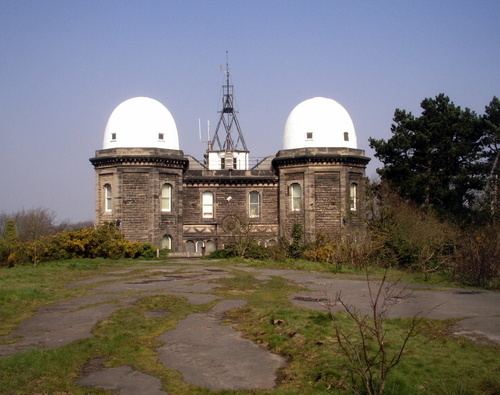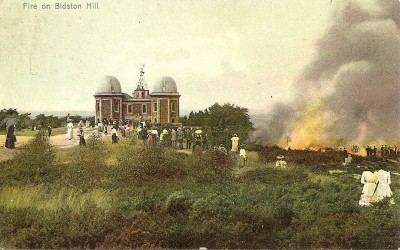Type Common Area 100 acres (0.40 km) Status Open | Open All year | |
 | ||
Operator Metropolitan Borough of Wirral Similar Bidston Lighthouse, Bidston Windmill, Flaybrick Hill Cemetery, Wirral Peninsula, Eccleston Park railway st | ||
Bidston Hill is 100 acres (0.40 km2) of heathland and woodland that contains historic buildings and ancient rock carvings. It is located on the Wirral Peninsula, near the Birkenhead suburb of Bidston, in Merseyside, England. With a peak of 231 feet (70 m), Bidston Hill is one of the highest points on the Wirral. The land was part of Lord Vyner's estate and purchased by Birkenhead Corporation in 1894 for use by the public.
Contents
- Bidston hill mountain bike loop
- Bidston Windmill
- Bidston Observatory
- Bidston Lighthouse
- Rock carvings
- Bidston Court
- Bidston Tunnels
- References

Bidston hill mountain bike loop
Bidston Windmill

Bidston Windmill replaced a wooden mill that was destroyed by fire in 1791, and was used to grind wheat until about 1875. However it is believed that there has been a windmill on this site since 1596. After falling into disuse it was bought and restored from 1894. It is open on the first Saturday of each month from April to September, between 10:00 a.m. and 12:00 noon.
Bidston Observatory
Bidston Observatory was built in 1866 using local sandstone excavated from the site. One of its functions was to determine the exact time. Up to 18 July 1969, at exactly 1:00 p.m. each day, the 'One O'Clock Gun' overlooking the River Mersey near Morpeth Dock, Birkenhead, would be fired electrically from the Observatory. In 1929 the work of the observatory was merged with the University of Liverpool Tidal Institute, being taken over in 1969 by the Natural Environment Research Council. The Research Council relocated the Proudman Oceanographic Laboratory to the University of Liverpool campus in 2004.
Bidston Lighthouse

There has been a lighthouse on Bidston Hill since 1771. Being more than two miles from the sea, it depended on a breakthrough in lighthouse optics, which came in the form of the parabolic reflector, developed at the signals station on Bidston Hill by Liverpool's dockmaster William Hutchinson. The reflector at Bidston Lighthouse was thirteen-and-a-half feet in diameter, and the lamp consumed a gallon of oil every four hours. The present lighthouse was built in 1873 and was operational until sunrise on 9 October 1913. Bidston and Leasowe Lighthouse together formed a pair of leading lights enabling ships to avoid the sandbanks in the channel to Liverpool. It is now privately owned, and occasionally open to the public.
Rock carvings
There is a 4 1⁄2-foot-long (1.4 m) carving of a Sun Goddess, carved into the flat rock north-east of the Observatory, supposedly facing in the direction of the rising sun on Midsummer's Day. and thought to have been carved by the Norse-Irish around 1000 AD. An ancient carving of a horse is located on bare rock to the north of the Observatory.
Bidston Court

Robert William Hudson built a house called 'Bidston Court' on Vyner Road South near Bidston Hill in 1891. Germany's Crown Prince Wilhelm was so impressed with the house that in 1913 he built a similar house, the Cecilienhof in Potsdam. The house was sold in 1921 to Sir Ernest Royden and in 1928 was moved to its present site in Frankby, brick by brick, finally being completed in 1931. It was renamed 'Hill Bark'. The original site of the house was given to Birkenhead Corporation.
Bidston Tunnels
During World War II, an air raid shelter was constructed at Bidston Hill. Today the tunnels are concealed for public safety.
